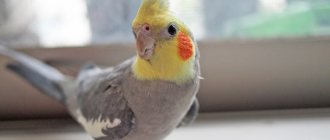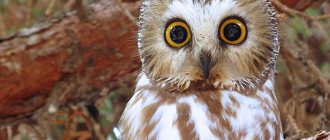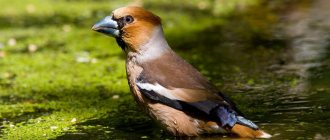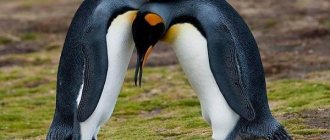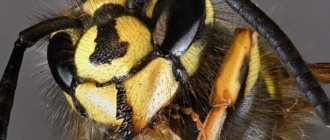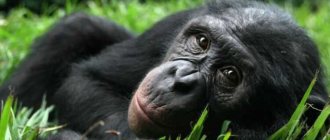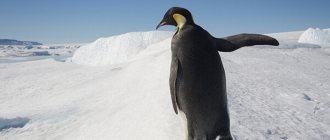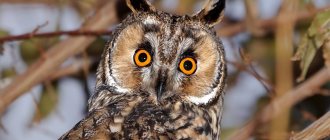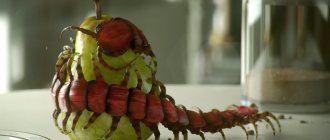Penguins (Spheniscidae) belong to the family of flightless seabirds, this is the only family in the order Penguinidae. It has 18 species, all of them beautiful and unusual in their own way. For example, the crested penguin of Antarctica is truly a miracle created by nature. After all, nature is the most talented sculptor and artist who breathes life into her creations!
The great crested penguin (Fudyptes sclateri) is a very interesting creature. The name “penguin” comes from the Welsh “pen”, which means “head”, and from the word “gwyn”, which means “white”. Adding these two words, we get “penguin”, for the sake of sweetness the letter “e” was changed to “i”. Although there is another version of the origin of this name. The sailors nicknamed the funny tumblers the word “pinguis”, translated from Latin as “fat”. This nickname is quite consistent with their physique.
Origin of the species and description
Photo: Crested penguin
The crested penguin belongs to the penguin family. The latest remains of small penguins are approximately 32 million years old. Despite the fact that penguins are mostly large, massive birds, their ancestors were much larger. For example, the largest representative of the remains ever found. His weight was about 120 kg.
Video: Crested penguin
The question of the intermediate link between large ancient penguins and small crested penguins remains open. It is likely that these birds were once adapted to flight, like albatrosses and gulls, but the aquatic lifestyle turned out to be most favorable for them. The connection between flying birds and flightless penguins has been lost
Birds from the penguin family have a number of features that are common to all of them:
- they live in packs. Penguins nest in large groups and huddle together for warmth during cold periods. Also, a collective way of life allows you to protect yourself from predators;
- The body shape of penguins is similar to a bullet, it is streamlined. So these birds can develop high speeds under water, like torpedoes or bullets;
- penguins can't fly. If chickens are capable of short flights, then the massive body of penguins with their small wings makes them incapable of even short flights;
- penguins walk vertically. The peculiarity of the structure of their spine is that it has almost no bends.
Penguins differ minimally from each other: size, color and some details by which they can be recognized. As a rule, the color of penguins has a camouflage function - a black back and head and a light belly. Penguins have a long beak that performs a grasping function and a long esophagus.
Interesting facts about the bird
Photo of a penguin swimming
- The average speed that a penguin can develop in water is 5-10 km/h. The fastest way of movement among penguins is called “dolphin swimming”; in this case, the bird jumps out of the water for a short time.
- During a day of hunting, a penguin swims about 27 km and spends about 80 minutes at a depth of more than 3 meters. The gentoo penguin can stay underwater for one to two minutes and dives to a depth of about 20 meters, but the emperor penguin remains underwater for up to 18 minutes and dives to a depth of about 500 meters.
- Coming out of the water onto the shore, penguins can jump to a height of up to 1.8 m. On land they waddle, and on ice they move quickly and cheerfully - they slide down slides while lying on their stomachs.
- In Central Europe and Russia, penguins are found only in zoos.
- The largest representative of penguins is the emperor penguin (height about 130 cm, weight up to 40 kg), and the smallest is the little penguin (height from 30 to 45 cm, weight 1-2.5 kg).
Appearance and features
Photo: What a crested penguin looks like
All subspecies of crested penguins are similar to each other. Their height ranges from 60 cm, weight about 3 kg. These small birds have a distinctive feature - the feathers above their eyes are elongated, bright yellow, forming peculiar eyebrows or crests, for which penguins got their name.
Interesting fact: Scientists have not established why the crested penguin needs yellow feathers above its eyes. So far the only assumption is that they play some role in the mating games of this species.
Crested penguins are characterized by waterproof plumage, which provides thermoregulation: it warms the bird during cold weather and cools it during hot periods. The penguin's beak is long, thick, and often has a reddish tint.
Crested penguins are a large species that includes several subspecies:
- rock crested penguin - stands out based on the location of its paws, which seem to be moved back to make it more convenient for the penguin to climb rocks;
- The northern crested penguin is the most endangered species. These are medium-sized birds with blacker plumage;
- Victoria penguin. It is distinguished by characteristic white spots in the cheek area. In general, the white belly area is more widespread than in other crested penguins;
- big penguin. In fact, not the largest subspecies - it is distinguished on the basis of its habitat on the Snares Archipelago - it is the smallest habitat among penguins;
- Schlegel penguin. An unusual light-colored subspecies of the crested penguin, which lacks golden tassels and a very thick beak. They have a silver-gray back with white markings and white paws. The feathers on the head have a barely noticeable golden tint;
- great crested penguin. The largest of the crested penguins. It is characterized by large feathers in structure, which look like a kind of chain mail;
- golden-haired penguin. In this subspecies, the yellow tassels above the eyes are most clearly visible. The first species of crested penguin to be discovered.
These penguins have minimal differences from each other; scientists do not agree on the identification of a single classification of crested penguins.
Where does the crested penguin live?
Photo: Crested penguin bird
Crested penguins are most widespread on the Subantarctic Islands, Tasmania, the Tierra del Fuego archipelago and on the coast of mainland South America. The bulk of the population is distributed at these points.
But certain subspecies of penguins live in the following places:
- Antipodes Islands, New Zealand, Campbell, Auckland, Bounty Islands - nesting site of great crested penguins;
- the islands of South Georgia, South Shetland, Orkney, and Sanditch Islands are the habitat of the golden-haired penguin;
- The large penguin lives exclusively on the Snares Archipelago - it inhabits an area of only 3.3 square km;
- the thick-billed penguin can be found on Stewart and Solander Islands near New Zealand;
- Macquarie Island is the only habitat of the Schlegel penguin;
- the northern subspecies lives on the islands of Tristan da Cunha and Gough Island.
Crested penguins choose rocky terrain as their habitat. All of them are adapted to varying degrees for walking on stones and rocks. Penguins try not to settle in the far north, as they do not tolerate winter well and lack of food. Although penguins are clumsy due to their body constitution, crested penguins are quite agile and dexterous. You can see them jumping from rock to rock and fearlessly diving into the water from high cliffs.
They settle in large flocks and build nests directly on rocks. It is important for them that even in the cold season, dry grass, branches and bushes can be found on the island, which are used to build a nest, although in most nests they are built from smooth small pebbles. Otherwise, penguins of both sexes insulate their nests with their own feathers.
Now you know where the crested penguin lives. Let's see what he eats.
Habitat
Vast areas, mainly in the cold regions of the Southern Hemisphere, are where penguins live. The largest populations are recorded in Antarctica. In addition, they feel quite comfortable in South Africa and southern Australia. Almost the entire coastline of South America is the territory where penguins live.
What does the crested penguin eat?
Photo: Crested penguin from the Red Book
Penguins eat whatever they can get in the sea and whatever they can fit into their beaks.
Usually this:
- small fish - anchovies, sardines;
- krill;
- crustaceans;
- shellfish;
- small cephalopods - octopuses, cuttlefish, squids.
Like king penguins, crested penguins are adapted to drink salt water. Excess salt is released through special glands located near the nose. Although, if there is access to fresh water, penguins will prefer to drink it. In the summer, crested penguins gain fat while swimming for a long time. During the winter they lose a significant part of their weight; also lose weight during mating games. While feeding the chicks, the female is responsible for feeding the young.
Interesting fact: The crested penguin prefers to bring whole fish or pieces of fish to its pups rather than regurgitate digested fish into their mouths.
Crested penguins move gracefully underwater. They are capable of reaching very high speeds in pursuit of prey. Like dolphins, crested penguins prefer to hunt in a flock, attacking a school of fish in a group, thereby disorienting them. Also, in a flock, a penguin is more likely to come out alive if it encounters a predator. Penguins are dangerous hunters. They swallow fish as they move and are capable of eating even very large individuals. Also, due to their small size and dexterity, they are able to get crustaceans and octopuses from gorges and other narrow places.
What do they eat
The diet of penguins is based on fish, crustaceans, plankton, as well as small representatives of cephalopods. Penguins happily eat anchovies and krill, sardines, Antarctic silverfish, squid and small octopuses. When these sea creatures hunt, they can make almost a thousand dives. The number of such dives depends on climatic conditions, as well as on species characteristics and the availability of food supply.
During the feeding process, these animals suck their prey into the oral cavity along with a certain amount of water. Therefore, salt water always enters the body of animals in excess. According to scientists' observations, while feeding, penguins travel up to 30 kilometers across the sea surface, while at a depth of more than 3 meters they spend up to an hour and a half a day.
Features of character and lifestyle
Photo: Pair of crested penguins
Crested penguins are not found alone; they are social birds. A flock of penguins can number more than 3 thousand individuals, which is a lot even by penguin standards. The habitat chosen is desert, consisting of stones and rare bushes near the sea. Although sometimes they settle near fresh lakes and rivers, they are usually small flocks that have strayed from the general colony. Crested penguins love to make noise. They constantly scream, and it is difficult not to hear their scream: it is ringing, hoarse and very loud. This is how penguins talk to each other and provide various information. At night, penguins are silent because they are afraid of attracting predators.
Crested penguins can be called the bravest and most aggressive penguin species. Each pair of penguins has its own territorial area, which it jealously guards. If another penguin enters their territory, both the female and the male will jealously fight for their rightful place. This attitude towards the territory is associated with the round small pebbles that are used to build the nest. It is a kind of penguin currency. Crested penguins not only collect pebbles on the shore, but also steal them from other nests.
Interesting fact: When a male remains on the nest and the female goes off to feed, other females come to this male and perform calling actions for mating. During mating, the male briefly leaves the nest and the female steals his pebbles for her nest.
Crested penguins are not limited to threatening calls - they are capable of striking with their beaks and the frontal part of their heads, which can injure their opponents. In a similar way, they protect their young and partners even from predators. Crested penguins also have family friends, to whom they are friendly. They usually hunt in groups and do not steal stones from each other. It is easy to recognize that penguins are on friendly terms - when they meet, they shake their heads from side to side, greeting a friend. Crested penguins are curious. They readily approach photographers and naturalists and can even attack people, although the little penguin cannot cause any injuries to humans.
Social structure and reproduction
Photo: Crested penguin family
The breeding season begins with fights in which males participate. Two penguins fight over the female, spreading their wings and hitting each other with their heads and beaks. All this is accompanied by a loud squeal. The winning penguin sings a song of low bubbling sounds to the female, after which mating occurs. The male builds the nest. It mainly consists of pebbles without sharp corners; he also drags branches and everything he finds in the area there. You can often find bottles, bags and other garbage there. In October, the female lays eggs (usually there are two of them, and one egg is larger than the second). During laying, the female does not eat, and the male brings her food.
In general, the male and female incubate the eggs alternately, and incubation lasts about a month. The hatched chicks remain entirely with the father. He provides them with warmth, and the female brings food and feeds herself. For the first month, the chicks stay with their father, and then they go to a kind of “nursery” - a place where penguin chicks gather and are under the supervision of adults. There they spend time until full maturity. After the chicks are left in public care, the birds actively accumulate fat. This allows them to prepare for the molt, which lasts just under a month. Having changed their fur, adult birds go to sea and spend the winter there, preparing for the next mating season.
Fun fact: Crested penguins sometimes form long-term pairs.
Penguins live for about 10 years; in captivity they can live up to 15.
Links[edit]
- "ITIS Standard Report Page: Eudyptes".
- Liddell, Henry George and Robert Scott (1980). Greek-English Lexicon (Abridged Edition)
. United Kingdom: Oxford University Press. ISBN 0-19-910207-4. - Christidis L, Boles WE (2008). Taxonomy and Taxonomy of Australian Birds
. Canberra: CSIRO Publishing. pp. 98–99. ISBN 978-0-643-06511-6. - Baker AJ, Pereira SL, Haddrath OP, Edge KA (2006). "Multiple genetic evidence for the spread of modern penguins beyond Antarctica due to global cooling". Proc Biol Sci
.
273
(1582): 11–17. DOI: 10.1098/rspb.2005.3260. PMC 1560011. PMID 16519228. - Williams (Penguins)
p. 69 - Williams (Penguins)
p. 52 - Williams (Penguins)
p. 76 - Williams (Penguins)
p. 38 - Absence, David (1968). Ecological devices for breeding birds. London: Methuen.
- Williams, Tony D. (1990). "Growth and survival of macaroni penguins Eudyptes chrysolophus
, A- and B-chicks: Do females maximize investment in a large B-egg."
Oikos
.
59
(3): 349–54. DOI: 10.2307/3545145. JSTOR 3545145. - ↑
Young, Ed (4 October 2016).
"Why Crested Penguins Always Lay Doomed Eggs". National Geographic
. Retrieved October 10 +2016.
Quoted text[edit]
- Williams, Tony D. (1995). Penguins
. Oxford, England: Oxford University Press. ISBN 0-19-854667-X. - Cole, Teresa L.; Ksepka, Daniil T.; Mitchell, Kieren J.; Tennyson, Alan J.D.; Thomas, Daniel B.; Pan, Haylin; Zhang, Guojie; Rawlence, Nicholas J.; Wood, Jamie R.; Bover, Pere; Bouzat, Juan L.; Cooper, Alan; Fiddamanl, Stephen; Hart, Tom; Miller, Gary; Ryan, Peter J.; Shepherd, Lara D.; Wilmshurst, Janet M.; Waters, Jonathan M. (2019). "Mitogenomes reveal extinct penguin taxa and show that island formation is a key driver of speciation." Molecular biology and evolution. DOI: 10.1093/molbev/msz017.
Natural enemies of the crested penguin
Photo: Great crested penguin
Due to their terrestrial lifestyle, penguins have almost no natural enemies. Many crested penguins live on isolated islands, where there is simply no one to attack them.
In water, penguins are vulnerable to some predators:
- leopard seals are formidable predators that quickly catch penguins in the water and can pose a danger on land;
- Antarctic fur seals can kill crested penguins, although seals primarily feed on fish;
- sea lions;
- killer whales have always hunted all types of penguins;
- some sharks are also found by penguins. They can circle around the islands where penguins live. When a bird wants to eat, it goes out to sea, even if there is a predator nearby, which is why it instantly becomes its prey.
Crested penguin chicks are the most vulnerable. “Nurses” are not always supervised by adults, which is why they can be attacked by brown skuas and some species of gulls. They attack both the chicks themselves and the clutches of penguins. Crested penguins are not defenseless birds. Although they are smaller in size than emperor and king penguins, crested penguins are very zealous in protecting themselves and their offspring. They are able to attack a predator by spreading their wings and screaming loudly. A flock of such screaming penguins is likely to frighten the enemy, causing him to move away.
Population and species status
Photo: What a crested penguin looks like
Along with the emperor, Galapagos and king penguins, the crested penguin is also endangered. The 20th century was not kind to crested penguins, as people actively killed them for fat and meat, and also plundered their egg clutches. The reasons for the disappearance of crested penguins today are the following: the expansion of agricultural zones that are at the junction with the habitats of crested penguins.
As a result, harmful industrial emissions affect life expectancy and the ability to reproduce. The second reason is poachers. There is still an opinion that penguin fat has healing properties. Climate change is also happening. Penguins are losing their habitats, which are being flooded with new tides. The number of fish and shellfish that are part of the penguins' daily diet is also declining. Due to unstable nutrition and climate change, penguins begin to breed less frequently - one clutch every two years.
Environmental pollution, especially plastic waste and petroleum products, also has an impact. Well, of course, the massive catch of fish, which is part of the diet of crested penguins, also affects their numbers. Despite the fact that the total population of crested penguins numbers more than three and a half million pairs, many subspecies are considered endangered. The population is expected to decline by about 70 percent over the next 20 years.
